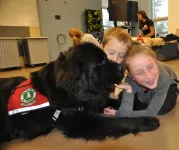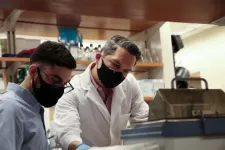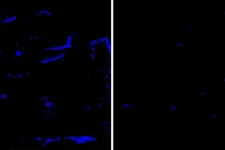(Press-News.org) A short-lived resurgence in the emission of ozone depleting pollutants in eastern China will not significantly delay the recovery of Earth's protective "sunscreen" layer, according to new research published Feb. 10 in Nature.
Stratospheric ozone, also known as Earth's ozone layer, helps shield us from the Sun's harmful Ultraviolet (UV) rays. Compounds like CFC-11 (Trichlorofluoromethane, also known as Freon-11), a chemical once considered safe and widely used as a refrigerant and in the production of insulation for buildings, rise to the stratosphere after emission on Earth's surface. Once in the atmosphere, CFC's are broken down by the UV light and result in the destruction of ozone molecules, both reducing stratospheric ozone concentrations globally and contributing to a "hole" in the layer that appears over Antarctica in the spring.
n 1987, the Montreal Protocol - an international treaty enacted to protect the ozone layer from additional degradation - banned new production and trade of ozone depleting substances like CFC-11. One hundred ninety-eight nations have since signed on to the agreement.
After production ceased, scientists still expected CFC-11 to continue leaking over the years from existing products, but at a gradually declining rate. Because of this, the gas is among those monitored at the global scale by the National Oceanic and Atmospheric Administration (NOAA)'s Global Monitoring Division and the Advanced Global Atmospheric Gases Experiment (AGAGE) - a network of monitoring stations funded by NASA and several environmental agencies, and headed by the Center for Global Change Science at the Massachusetts Institute of Technology and the Scripps Institute of Oceanography.
In 2018, NOAA first reported a smaller decrease in the decline of atmospheric CFC-11 than expected. The numbers didn't align with trajectories based on CFC-11's production ban, hinting that something had changed. "The slow-down in the rate of decline indicated that somebody was emitting again, or in larger quantities than we were expecting, we just didn't know where," says Matt Rigby, University of Bristol (UK) scientist and one of the lead authors of the new study.
It was the AGAGE network that helped track down the origins of much of the new emission of CFC-11 thanks to its geographic distribution. Two of its stations, the South Korean Gosan AGAGE station, run by Kyungpook National University in South Korea, and the AGAGE-affiliated station on Hateruma Island in Japan, run by Japan's National Institute of Environmental Studies, were both positioned close enough to the source for researchers to track much of the new emissions back to their source: eastern China.
"This is very much like detective work," said Qing Liang, a research scientist at NASA Goddard's Space Flight Center in Greenbelt, Md. and co-author of the study. "We figured out there was a problem, then we tracked down where the problem was regionally, and it seems that the actions taken in China, and perhaps elsewhere, have resulted in a big drop in the unexpected emissions [since 2018]."
Due in large part to effective monitoring, and subsequent reaction to the 2018 report, data and analysis in these two papers (published in February 2021) suggest that both the renewed eastern Chinese and overall global emissions of CFC-11 after mandated global phase out in 2010, have returned to previous levels.
Not only is this important for the ozone layer's recovery, but CFC-11 also impacts climate as a potent greenhouse gas. The observed levels of increased emission were comparable to the carbon dioxide emissions of a city roughly the size of London. In other words, closing off CFC-11 emissions has an additional climate benefit similar to that of shutting off a megacity.
Despite the monitoring success story, some emissions are still unaccounted for - and scientists have been unable to pinpoint where they are coming from due to current limitations of the monitoring network.
"The one critical piece of information we need is atmospheric observations," said Liang. "That's the reason why it is really important for NASA and NOAA, together with their international partners, to continue making measurements of these gases." Monitoring networks like the AGAGE stations are a valuable tool for understanding the role atmospheric chemistry plays in our changing climate.
Though these new CFC-11 emissions were identified relatively quickly, they have the potential to delay ozone layer recovery, especially if left unchecked, so a timely response is paramount.
"This was evidence for probably the biggest challenge that the Montreal Protocol has ever faced," said Rigby, "but I think it's been heartening to see how closely the science has been listened to by the parties of the Montreal Protocol, and then how rapidly the science has been acted on as well; All this has happened over the space of essentially two years, which is pretty incredible."
INFORMATION:
A neural network system that analyzes photographs can rank and distinguish suspicious, potentially precancerous skin lesions, which can turn into the deadly skin malignancy melanoma if not caught and removed early. The system accurately scoped out suspicious lesions from 68 patients in a manner that mostly matched tried-and-true evaluations from dermatologists. The results suggest the platform could help clinicians spot suspicious lesions during clinical visits faster and on a larger scale, potentially allowing for earlier diagnosis and treatment. Melanoma is ...
Understanding the molecular biology of brain tumors is key to prognosis and treatment said Le Bonheur Neuroscience Institute Co-Director Frederick Boop, MD, in his presentation "How Molecular Biology Impacts Clinical Practice" at the International Society for Pediatric Neurosurgery (ISPN) 2020 Virtual Meeting.
"Historically we have depended on what we see under a microscope to differentiate tumor types and determine prognosis and therapy," said Boop. "We know now that what we see doesn't necessarily predict how these tumors are going to behave."
Physicians are able to send a piece of a child's tumor to FoundationOne, an FDA-approved tissue-based broad companion diagnostic (CDx) for solid tumors, which provides the genomic alterations of that particular tumor. ...
A new UBC Okanagan study finds children not only reap the benefits of working with therapy dogs-they enjoy it too.
"Dog lovers often have an assumption that canine-assisted interventions are going to be effective because other people are going to love dogs," says Nicole Harris, who conducted this research while a master's student in the School of Education. "While we do frequently see children improve in therapy dog programs, we didn't have data to support that they enjoyed the time as well."
Harris was the lead researcher in the study that explored how children reacted while participating in a social skill-training program with therapy dogs.
The research saw 22 children from the Okanagan Boys and Girls ...
Resistance to tangle formation may help preserve memory
SuperAgers have fewer tangles than normally aging individuals
Future research to see how SuperAgers are protected
CHICAGO - A new Northwestern Medicine study showed cognitive SuperAgers have resistance to the development of fibrous tangles in a brain region related to memory and which are known to be markers of Alzheimer's disease.
The tangles are made of the tau protein which forms structures that transport nutrients within the nerve cell. These tangles disrupt the cell's transport system, ...
Nearly a half-million people a year die from sudden cardiac death (SCD) in the U.S. -- the result of malfunctions in the heart's electrical system.
A leading cause of SCD in young athletes is arrhythmogenic cardiomyopathy (ACM), a genetic disease in which healthy heart muscle is replaced over time by scar tissue (fibrosis) and fat.
Stephen Chelko, an assistant professor of biomedical sciences at the Florida State University College of Medicine, has developed a better understanding of the pathological characteristics behind the disease, as well as promising avenues for ...
The trial found that using sensor-based asthma inhalers may improve control of the condition and improve the quality of life for caregivers.
Greatest gains were among non-Hispanic Black participants, who experience more frequent and severe asthma than other groups.
Based on the study results, this asthma intervention should be considered for use by primary care, allergy and pulmonary care providers, to help engage diverse populations of pediatric asthma patients and their caregivers.
CHICAGO (February 17, 2021) -- Sensor-based inhalers integrated into health care providers' clinical workflows may help improve medication adherence and support children with asthma - and their families - to more effectively manage this condition, according ...
Numerous studies have shown that trained dogs can detect many kinds of disease -- including lung, breast, ovarian, bladder, and prostate cancers, and possibly Covid-19 -- simply through smell. In some cases, involving prostate cancer for example, the dogs had a 99 percent success rate in detecting the disease by sniffing patients' urine samples.
But it takes time to train such dogs, and their availability and time is limited. Scientists have been hunting for ways of automating the amazing olfactory capabilities of the canine nose and brain, in a compact device. Now, a team of researchers at MIT and other institutions has come up with a system that can detect the chemical and microbial content of an air sample with ...
As people age, a normal brain protein known as amyloid beta often starts to collect into harmful amyloid plaques in the brain. Such plaques can be the first step on the path to Alzheimer's dementia. When they form around blood vessels in the brain, a condition known as cerebral amyloid angiopathy, the plaques also raise the risk of strokes.
Several antibodies that target amyloid plaques have been studied as experimental treatments for Alzheimer's disease. Such antibodies also may have the potential to treat cerebral amyloid angiopathy, although they haven't yet been evaluated in clinical trials. ...
An international team led by researchers at the Centre for Palaeogenetics in Stockholm has sequenced DNA recovered from mammoth remains that are up to 1.2 million years old. The analyses show that the Columbian mammoth that inhabited North America during the last ice age was a hybrid between the woolly mammoth and a previously unknown genetic lineage of mammoth. In addition, the study provides new insights into when and how fast mammoths became adapted to cold climate. These findings are published today in Nature.
Around one million years ago there were no woolly or Columbian mammoths, as they had not yet evolved. This was the time of their predecessor, the ...
DURHAM, N.C. -- A new pair of studies from a Duke research team's long-term work in New Zealand make the case that mental health struggles in early life can lead to poorer physical health and advanced aging in adulthood.
But because mental health problems peak early in life and can be identified, the researchers say that more investment in prompt mental health care could be used to prevent later diseases and lower societal healthcare costs.
"The same people who experience psychiatric conditions when they are young go on to experience excess age-related physical diseases and neurodegenerative diseases when they are older adults," explained Terrie Moffitt, the Nannerl O. Keohane professor ...




